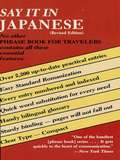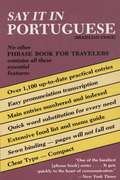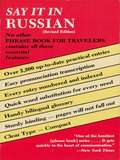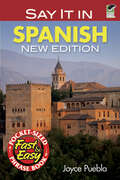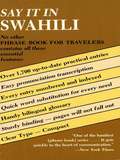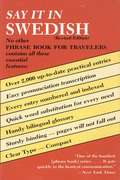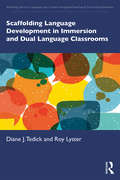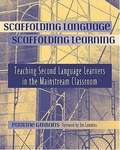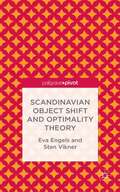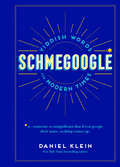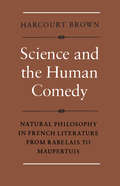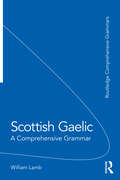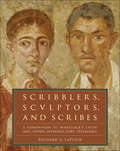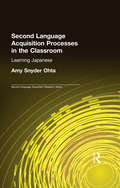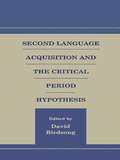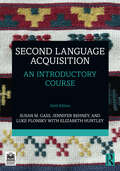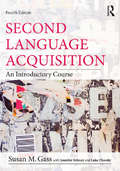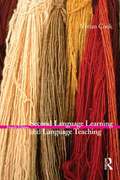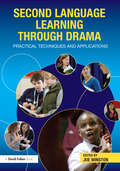- Table View
- List View
Say It in Japanese (Dover Language Guides Say It Series)
by DoverCompact and comprehensive, this handy guide belongs in the pocket of every traveler. Built to hold up to years of use, it offers the easiest method ever devised for quickly finding the words, phrases, and sentences you need to communicate clearly. The book features over 2,200 up-to-date entries for any occasion; simple pronunciation transcriptions; numbered and indexed entries; quick word substitutions; and a handy bilingual glossary.
Say It in Portuguese (Dover Language Guides Say It Series)
by DoverContains over 1,000 useful sentences and phrases for travel or everyday living abroad: food, shopping, medical aid, courtesy, hotels, travel, and other situations. Gives the English phrase, the foreign equivalent, and a transliteration that can be read right off. Also includes many supplementary lists, signs, and aids. All words are indexed.
Say It in Russian (Dover Language Guides Say It Series)
by DoverContains over 1,000 useful sentences and phrases for travel or everyday living abroad: food, shopping, medical aid, courtesy, hotels, travel, and other situations. Gives the English phrase, the foreign equivalent, and a transliteration that can be read right off. Also includes many supplementary lists, signs, and aids. All words are indexed.
Say It in Spanish: New Edition (Dover Language Guides Say It Series)
by Joyce PueblaCompact and comprehensive, this convenient reference contains more than 1,300 numbered entries for every occasion. Completely updated contents include vocabulary and phrases for modern technology, transportation, and communications, plus essential information for travelers and points of interest about language and culture. Contains a pronunciation guide, native food and drink list, and a 2,500-word English-Spanish dictionary. "Gets quickly to the heart of communication."--The New York Times.
Say It in Swahili (Dover Language Guides Say It Series)
by DoverContains over 1,000 useful sentences and phrases for travel or everyday living abroad: food, shopping, medical aid, courtesy, hotels, travel, and other situations. Gives the English phrase, the foreign equivalent, and a transliteration that can be read right off. Also includes many supplementary lists, signs, and aids. All words are indexed.
Say It in Swedish (Dover Language Guides Say It Series)
by DoverContains over 1,000 useful sentences and phrases for travel or everyday living abroad: food, shopping, medical aid, courtesy, hotels, travel, and other situations. Gives the English phrase, the foreign equivalent, and a transliteration that can be read right off. Also includes many supplementary lists, signs, and aids. All words are indexed.
Scaffolding Language
by Pauline GibbonsThe bestselling Scaffolding Language, Scaffolding Learning helped tens of thousands of mainstream elementary teachers ensure that their English language learners became full members of the school community with the language and content skills they needed for success. In the highly anticipated Second Edition, Pauline Gibbons updates her classic text with a multitude of practical ideas for the classroom, supported by the latest research in the field of ELL/ESL. With clear directions and classroom tested strategies for supporting students' academic progress, Gibbons shows how the teaching of language can be integrated seamlessly with the teaching of content, and how academic achievement can be boosted without sacrificing our own vision of education to the dictates of knee-jerk accountability. Rich examples of classroom discourse illustrate exactly how the scaffolding process works, while activities to facilitate conversation and higher-level thinking put the latest research on second language learning into action.
Scaffolding Language Development in Immersion and Dual Language Classrooms (Routledge Series in Language and Content Integrated Teaching & Plurilingual Education)
by Roy Lyster Diane J. TedickThis book introduces research-based pedagogical practices for supporting and enhancing language development and use in school-based immersion and dual language programs in which a second, foreign, heritage, or indigenous language is used as the medium of subject-matter instruction. Using counterbalanced instruction as the volume’s pedagogical framework, the authors map out the specific pedagogical skill set and knowledge base that teachers in immersion and dual language classrooms need so their students can engage with content taught through an additional language while continuing to improve their proficiency in that language. To illustrate key concepts and effective practices, the authors draw on classroom-based research and include teacher-created examples of classroom application. The following topics are covered in detail: defining characteristics of immersion and dual language programs and features of well-implemented programs strategies to promote language and content integration in curricular planning as well as classroom instruction and performance assessment an instructional model to counterbalance form-focused and content-based instruction scaffolding strategies that support students’ comprehension and production while ensuring continued language development an approach to creating cross-linguistic connections through biliteracy instruction a self-assessment tool for teachers to reflect on their pedagogical growth Also applicable to content and language integrated learning and other forms of content-based language teaching, this comprehensive volume includes graphics to facilitate navigation and provides Resources for Readers and Application Activities at the end of each chapter. The book will be a key resource for preservice and in-service teachers, administrators, and teacher educators.
Scaffolding Language, Scaffolding Learning: Teaching Second Language Learners in the Mainstream Classroom
by Jim Cummins Pauline GibbonsHow does a mainstream elementary classroom teacher with little or no specialized ESL training meet the challenge of teaching linguistically diverse students? Pauline Gibbons suggests how: integrate the teaching of English with the content areas of the regular curriculum. What's more, she shows how in this practical resource book. Gibbons begins with a strong theoretical underpinning for her practice, drawing on a functional model of language, sociocultural theories of learning, and current research on second-language development. After supporting her view that the regular curriculum offers the best language-learning environment for young ESL students, Gibbons demonstrates the ways in which content areas provide a context for the teaching of English, from speaking and listening to reading and writing. These in turn are treated not as discrete skills, but as ones that can also be integrated in the learning of diverse subjects. Gibbons illustrates this with a wide range of teaching and learning activities across the curriculum, supplemented with programming and assessment formats and checklists. Language learning is not a simple linear process, but involves the ongoing development of skills for a range of purposes. Gibbons sees this development as largely the result of the social contexts and interactions in which learning occurs. By focusing on the ways in which teachers can "scaffold" language and learning in the content areas, she takes a holistic approach-one that appreciates the struggle of students learning a new language, while simultaneously developing subject knowledge in it, and the challenge for teachers to address these needs. Given today's culturally and linguistically diverse classrooms, ESL students can no longer be thought of as a group apart from the mainstream-they are. the mainstream. This book describes the ways to ensure that ESL learners become full members of the school community with the language and content skills they need for success.
Scalarity in the Verbal Domain
by Olga KaganVerbal prefixes in Slavic languages remain an intricate and puzzling phenomenon, raising questions about whether their behavior is governed by a systematic pattern, and if their attachment is subject to any kind of uniform semantic system. Olga Kagan offers a new unified analysis of Russian verbal prefixes which combines a formal semantic approach with detailed discussion of data. The book addresses two vital issues, both of which play an important role in modern linguistic research: the role of scalarity in natural language and, more specifically, within the verbal domain; and Slavic verbal prefixation. Accessibly written and illustrated with numerous examples, Scalarity in the Verbal Domain is important reading for researchers and students of formal semantics, cognitive linguistics and Slavic languages.
Scandinavian Object Shift and Optimality Theory
by Sten Vikner Eva EngelsThis book presents an account of object shift, a word order phenomenon found in most of the Scandinavian languages where an object occurs unexpectedly to the left and not to the right of a sentential adverbial. With new and original observations, it is an important addition to the fields of phonology, optimality theory and theoretical syntax.
Schmegoogle
by Daniel KleinSchmegoogle: n. : a person so insignificant that if you Google his name, nothing comes up.Schmegoogle: Yiddish Words for Modern Times is a hilariously useful lexicon of neologisms that capture the flavor of life as we live it today.This clever book introduces more than 200 new terms rooted in real Yiddish, accompanied funny use-it-in-a-sentence examples and entertaining etymology.• Yiddish has long enriched English language slang.• Covers subjects including technology, family, dating, anxiety, insults and more• All terms are a unique blend of classic Yiddish with modern topicsIn this fast-changing modern world experienced online and through apps, of foodies, legal weed, and shifting social constructs, our need for the expressive wonders of Yiddish has never been greater. Bothered by that unanswered drift of e-mail piling up (e-charazi), stuffed by food or worry (gifilted), feeling like the dating app sends in only clowns (a zhlub magnet)? Schmegoogle is here to help.• Hilarious useful Yiddish neologisms for the 21st century• Makes a great gift for Jewish holidays or anyone who loves Jewish humor, as well as language nerds.• Perfect to for any occasion• You'll love this book if you love books like Yiddish with Dick and Jane by Ellis Weiner and Barbara Davilman, Born to Kvetch: Yiddish Language and Culture in All of Its Moods by Michael Wex, and Yiddish with George and Laura by Ellis Weiner, Barbara Davilman.
Scholastic Read XL (Grade #7)
by ScholasticIt's the first day of seventh grade. Will Victor make a good impression on the girl of his dreams?
Scholastic Read XL (Grade #8)
by ScholasticSurveys can be a great way to learn about people's opinions and habits. But when you read the results of a survey, there are some details you should check.
Scholastic Read XL, Grade 6, Level 1: Student Anthology
by ScholasticScholastic Read XL, Grade 6, Level 1: Student Anthology is a school textbook, full of short stories with discussion questions at end of each story.
Schottenfreude: German Words for the Human Condition
by Ben SchottSchottenfreude is a unique, must-have dictionary, complete with newly coined words that explore the idiosyncrasies of life as only the German language can.Ever thought, There should be a German word for that? Well, thanks to the brilliantly original mind behind Schott&’s Original Miscellany, now there is. In what other language but German could you construct le mot juste for a secret love of bad foods, the inability to remember jokes, Sunday-afternoon depression, the urge to yawn, the glee of gossip, reassuring your hairdresser, delight at the changing of the seasons, the urge to hoard, or the ineffable pleasure of a cold pillow? A beguiling, ideal gift book for the Gelehrte or anyone on your list—just beware of rapidly expanding (and potentially incomprehensible) vocabularies.
Science and the Human Comedy: Natural Philosophy in French Literature from Rabelais to Maupertuis
by Harcourt BrownNew scientific theories, methods, and objectives exert subtle and often unnoticed influences on literary creation. The developments of the attitudes and aspirations of French scientists between the Renaissance and the Revolution and the impact of these new outlooks on French literature form the theme of this book by an authority in the interdisciplinary treatment of science and literature. Implicit in the author's exploration is the view that in the development of the scientific revolution there was no overall design, but rather random growth; human beings turn up at various moments, some of them appropriately, some of them not, so that the record is in part a story of successful endeavour, in part a comedy little short of farce. in the historical panorama of this book, four auhors, each known for his ironic, even comic, insight into the human condition, are chosen to illustrate the theme. As men of letters, Rabelais and Voltaire exhibit well-defined scientific interests, while Pascal and Maupertuis were drawn from their scientific vocations into the discussion of ideas in literary forms. Consideration of their similarities and differences suggested the title, Science and the Human Comedy. This work is a valuable contribution to our understanding of the historical and cultural conditions accompanying the advancement of science in a critical period, as well as of several ways in which the process was reflected, sometimes directly, more often indirectly, in literature. (University of Toronto Romance Series 30)
Scottish Gaelic: A Comprehensive Grammar (ISSN)
by William LambScottish Gaelic: A Comprehensive Grammar is a definitive description of contemporary Gaelic.The volume presents an authoritative account of modern Gaelic grammar, attending to both idealised usages – as typically taught in formal education – and more colloquial forms. Core chapters include useful observations about dialectal and register differences, such as variations in inflection, pronunciation and word forms. The book also demystifies nuances of the language that many users find opaque, according to recent research. In each chapter, the most important, basic information is presented first (e.g. standard verb conjugations), followed by increasingly detailed information for more advanced users. This way, the book addresses the diverse needs of its intended audience. Brimming with authentic examples, the volume accommodates readers of all levels, from complete beginners to professional linguists. It is both an ideal textbook for structured coursework and an indispensable companion for independent study.
Scribblers, Sculptors, and Scribes: A Companion to Wheelock's Latin and Other Introductory Textbooks
by Richard A. LaFleurAn outstanding and enjoyable companion reader to the Wheelock’s curriculum, or any introductory Latin textbook.From one of the country’s leading Latinists, this reader is the perfect complement to any Latin program, and the first collection of entirely authentic classical Latin texts that beginning students, from the very first day of their introduction to Latin, can read and enjoy.Beginning with simple graffiti, Scribblers, Sculptors, and Scribes moves toward longer inscriptions and literary texts as students progress. Designed to accompany the bestselling Wheelock’s curriculum, its 40 chapters are linked with the 40 chapters of Wheelock’s Latin, but the book’s readings and design features make it suitable for use alongside any introductory college or high-school Latin textbook. Packed with hundreds of actual Latin inscriptions, proverbs, and texts, this outstanding textbook also includes dozens of photos and illustrations, maps, discussion and comprehension questions, grammar capsules, a Latin–English vocabulary section, a summary of forms, and much more.
Second Language Acquisition Processes in the Classroom: Learning Japanese (Second Language Acquisition Research Series)
by Amy Snyder OhtaThis book is the first study to examine how interactional style develops within the walls of a foreign language classroom in the first two years of language study. Results show learners to be highly sensitive to pragmatic information and that learners can move toward an appropriate interactional style through classroom interactive experience. The book shows how learners are most often sources who offer assistance and correction, with errors serving most often to stimulate further thinking about what form is correct. Analysis shows learners to be active in seeking corrective information in the classroom setting, not only from peer partners but also from the teacher. They are active in noticing how the teacher's utterances--even when addressed to others--contrast with their own, and utilize corrective feedback intended for other students. In addition, the results show that teacher-initiated corrective feedback addressed to individual learners is only one source of corrective feedback. Learners are shown to be active in both teacher-fronted and peer interactive settings. In newer L2 teaching methodologies which focus on the use of peer interactive tasks, the teacher's role has been de-emphasized. This book, however, shows how important the teacher's role is. The final chapter examines how the teacher can act to maximize the benefits of peer interactive tasks through how they design tasks and present them to the class. First, the chapter looks at how learners use English--their L1--in the classroom, concluding that how teachers present activities to the class has an impact on the amount of L1 used by students during peer interaction. Following up on this finding, the chapter works to address questions that teachers face in lesson planning and teaching. It presents a useful list of questions teachers can ask when designing peer interactive tasks in order to maximize the effectiveness of a wide variety of language learning tasks.
Second Language Acquisition and the Critical Period Hypothesis (Second Language Acquisition Research Series)
by David BirdsongSecond Language Acquisition and the Critical Period Hypothesis is the only book on the market to provide a diverse collection of perspectives, from experienced researchers, on the role of the Critical Period Hypothesis in second language acquisition. It is widely believed that age effects in both first and second language acquisition are developmental in nature, with native levels of attainment in both to be though possible only if learning began before the closure of a "window of opportunity" – a critical or sensitive period. These seven chapters explore this idea at length, with each contribution acting as an authoritative look at various domains of inquiry in second language acquisition, including syntax, morphology, phonetics/phonology, Universal Grammar, and neurofunctional factors. By presenting readers with an evenly-balanced take on the topic with viewpoints both for and against the Critical Period Hypothesis, this book is the ideal guide to understanding this critical body of research in SLA, for students and researchers in Applied Linguistics and Second Language Acquisition.
Second Language Acquisition: An Introductory Course
by Susan M. Gass Jennifer Behney Luke Plonsky Elizabeth HuntleyNow in its sixth edition, this bestselling textbook remains the cornerstone for the study of second language acquisition, providing a comprehensive yet accessible introduction to SLA.This substantially revised and updated edition has been edited into ten chapters, with a focus on the most frequently taught core themes and increased accessibility. A new introductory chapter provides a concise overview of the history of the field. Omitted chapters are available online where supplementation is desired. The text continues to provide a rich range of pedagogical tools that encourage students to reflect upon the experiences of second language learners. As with previous editions, discussion questions and problems are peppered throughout each chapter to help students apply their knowledge, and a glossary defines and reinforces must-know terminology. Additional questions and problems appear on the online companion website.This seminal text is ideal core reading for SLA courses in second language studies, applied linguistics, linguistics, TESOL, and/or language education programs. This textbook is supported with Instructor and Student Resources, including PowerPoint slides, exercises, flashcards, audio and video links: www.routledge.com/cw/gass.
Second Language Acquisition: An Introductory Course
by Susan M. GassNow in a fourth edition, this bestselling introductory textbook remains the cornerstone volume for the study of second language acquisition (SLA). Its chapters have been fully updated, and reorganized where appropriate, to provide a comprehensive yet accessible overview of the field and its related disciplines. To reflect current developments, new sections on using learner corpora, semantics and morphosyntax (within formal approaches to SLA), sociocultural approaches, gesture, priming research, and chaos theory have been added. Students will also find expanded discussions of heritage language learning, bilingualism, pragmatics, and much more. The redesigned fourth edition of Second Language Acquisition retains the features that students found useful in the current edition but also provides new pedagogical tools that encourage students to reflect upon the experiences of second language learners. As with previous editions, discussion questions and problems at the end of each chapter help students apply their knowledge, and a glossary defines and reinforces must-know terminology. This clearly-written, comprehensive, and current textbook, by expert Sue Gass, is the ideal textbook for the introductory SLA course in second language studies, applied linguistics, linguistics, TESOL, and language education programs.
Second Language Learning and Language Teaching
by Vivian CookThe fourth edition of this classic textbook has been revised to reflect recent developments in language teaching and learning yet retains the basic structure and approach so popular with its readers. Teaching and learning content has been updated, particularly taking into account the rise of task-based learning, Conversational Analysis and social models of second language acquisition, changes in national syllabuses and examinations and the increasing controversy over the role of the native speaker target. Each chapter has been revised to stand alone, enabling the text to be taught and studied out of sequence if preferred. A set of focusing questions has also been added to each and further reading sections have been updated. Second Language Learning and Language Teaching remains the essential textbook for all student teachers of modern languages and TESOL as well as applied linguistics.
Second Language Learning through Drama: Practical Techniques and Applications
by Joe WinstonDrama is increasingly being recognised as a valuable pedagogy for language learning as it can harness children‘s imaginations and stimulate their desire to communicate. Second Learning Language through Drama draws on current theories of additional and foreign language learning and illustrates through practical case studies how drama can be used to support the four key skills of listening, speaking, reading and writing. Drawing on the work of an international group of practitioners who are all highly experienced in using drama for the purpose of second language learning, the book clearly explains key drama conventions and strategies and outlines the innovative ways they have been used to create enjoyable and stimulating classroom activities that allow for multiple ways of learning. Throughout the book the emphasis is on making language learning accessible and relevant to children and young people through creative, physically active and playful approaches. The strategies described are all highly flexible and readily adaptable to different teaching contexts. Specific themes include: Using stories and drama to motivate learners at all levels Drama, language learning and identity Assessment opportunities through process drama Issues of language learning and cultural empowerment Digital storytelling Film & drama aesthetics Second Language Learning through Drama will be of great interest to those studying on undergraduate and postgraduate courses and will serve as a highly valuable text to practitioners looking to incorporate the approaches described into their lessons and classroom activities.
